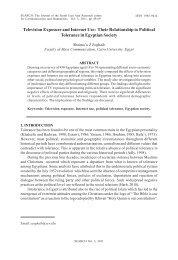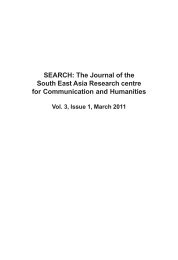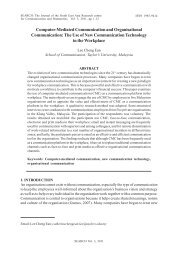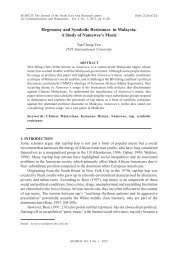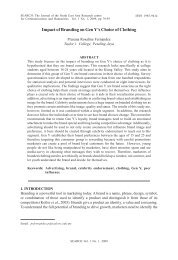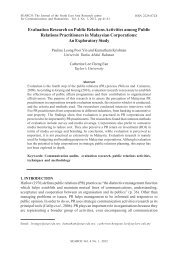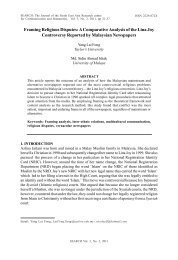Framing Analysis of a Conflict: War/Peace Journalism - Nicole Yang ...
Framing Analysis of a Conflict: War/Peace Journalism - Nicole Yang ...
Framing Analysis of a Conflict: War/Peace Journalism - Nicole Yang ...
- No tags were found...
You also want an ePaper? Increase the reach of your titles
YUMPU automatically turns print PDFs into web optimized ePapers that Google loves.
<strong>Framing</strong> <strong>Analysis</strong> <strong>of</strong> a <strong>Conflict</strong>: <strong>War</strong> / <strong>Peace</strong> <strong>Journalism</strong> 254.4 Indicators <strong>of</strong> <strong>Peace</strong> <strong>Journalism</strong> for the Coverage <strong>of</strong> Keris Wielding ActAs shown in Table 3, the indicators supporting peace journalism frame for the coverage <strong>of</strong>the keris wielding act, based on a total frequency count <strong>of</strong> 31, were agreement orientation(60%), avoidance <strong>of</strong> labelling <strong>of</strong> good and bad (55%), causes-and-consequences approach(20%), and non-partisanship (20%).In pursuing an agreement orientation, the articles reported on areas that might lead toa solution for the keris wielding issue. The coverage included voices giving credit toHishammuddin for his contribution as an Education Minister to the non-Malays. Therewere also articles that reported the explanation for keris wielding given by Hishamuddinand other UMNO leaders. Besides, there were quotes by BN leaders that urged the non-Malays not to worry about the act <strong>of</strong> keris wielding; not to be influenced by the racialsentiment; to disseminate Hishammuddin’s explanation to others; and to quit the debateand put it to rest. Some articles also reported assurances from the government that all ethnicgroups will be protected.Through avoidance <strong>of</strong> labelling <strong>of</strong> good and bad, the articles did not assign blame toanyone. By adopting causes-and-consequences approach, the news items reported factorscontributing to the keris wielding conflict. It was reported that the issue was not with thekeris but the context in which it was wielded. The non-Malays perceived the action <strong>of</strong>Hishammudin wielding the keris for three consecutive years as defending ketuanan Melayu(Malay supremacy) and to threaten those who oppose Malay special rights. The non-Malays also felt that wielding a keris at a highly charged political meeting was confrontational,combative and trampled on the rights and sensitivities <strong>of</strong> the non-Malays.The articles were neutral by being non-partisan. This means that the news items neitherportrayed the keris or keris wielding act favourably nor unfavourably; neither supportednor condemned Hishammuddin and the government.4.5 Indicators <strong>of</strong> <strong>War</strong> <strong>Journalism</strong> for Coverage <strong>of</strong> ApologyAs represented in Table 5 the indicators supporting war journalism frame for the coverage <strong>of</strong>apology, based on a total frequency count <strong>of</strong> 34, were elite orientation (100%), partisanship(78.6%), dichotomy <strong>of</strong> the good and bad (45.5%), and differences orientation (28.6%).As in the case <strong>of</strong> coverage <strong>of</strong> the keris wielding act, Sin Chew Daily also relied 100%on the elites as the source <strong>of</strong> information while ignoring the common citizen in its coverage<strong>of</strong> apology. These elites included those from the United Malays National Organisation(UMNO) (42.9%); Malaysian People’s Movement Party (Gerakan) (14.3%); MalaysianChinese Association (MCA) (7.1%); Malaysian Indian Congress (MIC) (7.1%), DemocraticAction Party (DAP) (14.3%); and Sin Chew Daily’s editorial board (7.1%).Among the articles that exhibited partisanship, 72.7% conveyed a favourable impressionon the apology, while only 27.3% conveyed a negative meaning toward the issue. Througha dichotomy <strong>of</strong> bad and good perspectives, the articles reported that it was not merelyHishammuddin’s fault in the keris wielding conflict, rather, other quarters like a few UMNOdelegates who made racist remarks, the Opposition parties and foreign media were those tobe blamed for making the issue sensitive. There was an article which quoted the speech <strong>of</strong>an UMNO representative, who criticised the Chinese and Indians for being demanding.SEARCH Vol. 1 No. 1, 2009



